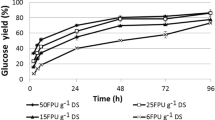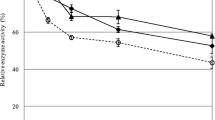Abstract
Comparative studies between commercial Trichoderma reesei cellulase preparations show that, depending on the preparation and loading, total protein precipitation can be as high as 30 % under standard hydrolysis conditions used for lignocellulosic materials. ATR-IR and SDS-PAGE data verify precipitates are protein-based and contain key cell wall hydrolyzing enzymes. Precipitation increased considerably with incubation temperature; roughly 50–150 % increase from 40 to 50 °C and 800 % greater at 60 °C. All of the reported protein losses translated into significant, and often drastic, losses in activity on related 4-nitrophenyl substrates. In addition, supplementation with the non-ionic surfactant PEG 6,000 decreased precipitation up to 80 % in 24 h precipitation levels. Protein precipitation is potentially substantial during enzymatic hydrolysis of lignocelluloses and should be accounted for during lignocellulose conversion process design, particularly when enzyme recycling is considered.





Similar content being viewed by others
References
Adney WS, Jeoh T, Beckham GT, Chou YC, Baker JO, Michener W, Brunecky R, Himmel ME (2009) Probing the role of N-linked glycans in the stability and activity of fungal cellobiohydrolases by mutational analysis. Cellulose 16(4):699–709
Barnes RJ, Dhanoa MS, Lister SJ (1989) Standard normal variate transformation and de-trending of near-infrared diffuse reflectance spectra. Appl Spectrosc 43(5):772–777
Hall M, Rubin J, Behrens SH, Bommarius AS (2011) The cellulose-binding domain of cellobiohydrolase Cel7A from Trichoderma reesei is also a thermostabilizing domain. J Biotechnol 155(4):370–376
Himmel ME, Ding SY, Johnson DK, Adney WS, Nimlos MR, Brady JW, Foust TD (2007) Biomass recalcitrance: engineering plants and enzymes for biofuels production. Science 315:804–807
Kohlmann KL, Westgate P, Velayudhan A, Weil J, Sarikaya A, Brewer MA, Hendrickson RL, Ladisch MR (1995) Enzyme conversion of lignocellulosic plant materials for resource recovery in a controlled ecological life support system. Adv Space Res 18:251–265
Kong J, Yu S (2007) Fourier transform infrared spectroscopic analysis of protein secondary structures. Acta Biochim Biophys Sin 39(8):549–559
Kristensen JB, Borjesson J, Bruun MH, Tjerneld F, Jørgensen H (2007) Use of surface active additives in enzymatic hydrolysis of wheat straw lignocellulose. Enzym Microb Technol 40:888–895
Mahler HC, Huber F, Kishore RSK, Reindl J, Ruckert P, Muller R (2010) Adsorption behavior of a surfactant and a monoclonal antibody to sterilizing-grade. J Pharma Sci 99:2620–2627
Qi B, Chen X, Su Y, Wan Y (2011) Enzyme adsorption and recycling during hydrolysis of wheat straw lignocellulose. Biores Technol 102:2881–2889
Randolph TW, Jones LS (2002) Surfactant-protein interactions. In: Carpenter JF, Manning MC (eds) Rational design of stable protein formulations. Kluwer/Plenum, New York, pp 159–175
Selig MJ, Adney WS, Himmel ME, Decker SR (2009) The impact of cell wall acetylation on corn stover hydrolysis by cellulolytic and xylanolytic enzymes. Cellulose 16:711–722
Tu M, Chandra RP, Saddler JN (2007) Recycling cellulases during the hydrolysis of steam exploded and ethanol pretreated lodgepole pine. Biotechnol Prog 23:1130–1137
Tu M, Zhang X, Paice M, MacFarlane P, Saddler J (2009) The potential of enzyme recycling during the hydrolysis of a mixed softwood feedstock. Biores Technol 100:6407–6415
Varnai A, Viikari L, Marjamaa K, Siika-aho M (2011) Adsorption of monocomponent enzymes in enzyme mixture analyzed quantitatively during hydrolysis of lignocellulose substrates. Biores Technol 102:1220–1227
Vinzant TB, Adney WS, Decker SR, Baker JO, Kinter MT, Sherman NE, Fox JW, Himmel ME (2001) Fingerprinting Trichoderma reesei hydrolases in a commercial cellulase preparation. Appl Biochem Biotechnol 91–93:99–107
Wood TM, Bhat KM (1988) Methods for measuring cellulase activities. Method Enzymol 160:87–112
Yang B, Wyman C (2006) BSA treatment to enhance enzymatic hydrolysis of cellulose in lignin containing substrate. Biotechnol Bioeng 94:611–617
Acknowledgments
This work was supported by the project “Demonstrating Industrial scale second generation bioethaol production—Kalundborg Cellulosic Ethanol Plant” under the EU FP7 framework program and the project “Development of improved second generation (2G) bioethanol technology to prepare for commercialization under the Danish Energy Technology and Demonstration Programme (EUDP).
Author information
Authors and Affiliations
Corresponding author
Rights and permissions
About this article
Cite this article
Chylenski, P., Felby, C., Østergaard Haven, M. et al. Precipitation of Trichoderma reesei commercial cellulase preparations under standard enzymatic hydrolysis conditions for lignocelluloses. Biotechnol Lett 34, 1475–1482 (2012). https://doi.org/10.1007/s10529-012-0916-5
Received:
Accepted:
Published:
Issue Date:
DOI: https://doi.org/10.1007/s10529-012-0916-5




